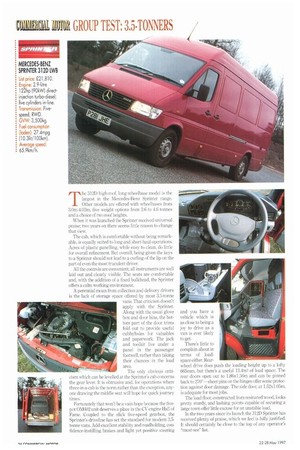T he 3121) high-roof, long-wheelbase model is the largest in the
Page 38

Page 39

If you've noticed an error in this article please click here to report it so we can fix it.
Mercedes-Benz Sprinter range. Other models are offered with wheelbases from 3.0m-4.03m, five weight options from 2.6 to 4.6 tonnes and a choice of two roof heights.
When it was launched the Sprinter received universal praise; two years on there seems little reason to change that view .
The cab, which is comfortable without being remark able, is equally suited to long and short-haul operations. Acres of plastic panelling, while easy to clean, do little for overall refinement. But overall, being given the keys to a Sprinter should not lead to a curling of the lip on the part of even the most truculent driver.
All the controls are convenient, all instruments are well laid out and clearly visible. The seats are comfortable and, with the addition of a fixed bulkhead, the Sprinter offers a calm working environment.
A perennial moan from collection and delivery drivers is the lack of storage space offered by most 3.5-tonne vans. That criticism doesn't apply with the Sprinter. Along with the usual glove box and door bins, the bottom part of the door trims fold out to provide useful cubbyholes for valuables and paperwork. The jack and toolkit live under a panel in the passenger footwell, rather than taking their chances in the load area.
The only obvious criti(ism wlat:11 can be levelled at the Sprinter's cab concerns the gear lever. It is obtrusive and, for operations where three-in-a-cab is the norm rather than the exception, anyone drawing the middle seat will hope for quick journey times.
Fortunately that won't be a vain hope because the fivepot 0M602 unit deserves a place in the CV engine Hall of Fame. Coupled to the slick five-speed gearbox, the Sprinter's driveline has set the standard for modern 3.5tonne vans. Add excellent stability and roadholding, confidence-instilling brakes and light yet positive steering and you have a vehicle which is as close to being a joy to drive as a van is ever likely to get.
There's little to complain about in terms of loadspace either. Rearwheel drive does push the loading height up to a lofty 665mm, but there's a useful 13.4m3 of load space. The rear doors open out to 1.86x1.56m and can be pinned back to 270°—sheer pins on the hinges offer some protection against door damage. The side door, at 1.52x1.05m, is adequate for most jobs.
The load floor, constructed from resinated wood, looks pretty sturdy, and lashing points capable of securing a large town offer little excuse for an unstable load.
In the two years since its launch the 3121) Sprinter has received plenty of praise, which we feel is fully justified. It should certainly be close to the top of any operator's "must-see" list.
The Fiat Ducat) 2.5 Maxi TD is a product of Sevel, the joint venture set up in 1981 by Fiat and NA, the Peugeot-Citroen combine. The Maxi DNB is the biggest model in the range, offering a payload of 1.560kg, and a loadspace of 12m3. Fiat offers other models with payloads ranging from 1,195-1,260kg on wheelbases of 2.85m, 3.2m or 3.7m with roof heights of 2.13m, 2,165m and 2.47m.
The Ducato cab is a pleasant driving environment.
Thanks to its dashboard-mounted gear lever the Fiat is the best of this quartet as far as accommodation for three is concerned. The dashboard layout shows signs of careful planning; instrument visibility is good, with most controls being readily to hand although the radio position does little for safety and the handbrake (mounted on the floor to the right of the driver) is not as accessible as it might be. All-round visibility is good and noise levels are acceptable.
However good the cab design might be, lack of storage space ranks as a serious oversight. The ux)lkit and jack are left out in the open, and space for maps and paperwork is in short supply.
Compared with the Sprinter, the door mountings on the Ducato are disconcerting. Push the hinges the wrong way and the panel flexes: smack the open door at 30mph and the words "write" and "off" will apply. By the nature of the work they generally do, 3.5-tonne vans do not have the calmest of existences and shear pins are a simple way of avoiding extremely costly damage. Where the Ducat() really starts to turn heads is in the load area. A low loading height of 560mm lends itself to convenient operation, as does a loading aperture of 1.76x1.56m. But the rear doors only open out to a maximum of 180°, making loading hay work awkward.
Perhaps more impressive is the inclusion of a fullheight side door on both sides of the vehiCle.
Coupled with the load space's completely fiat floor, awkward-shaped loads should present the Ducato operator with few problems.
The Ducat() may lack some of the refinement of the Sprinter, and we would tend to back the Mere 0M602 engine over the Fiat 8140.47 for most applications, but it offers comfortable accommodation for three and a very practical load area. This could well tip the balance in its favour with big van buyers.
















































































































